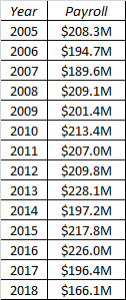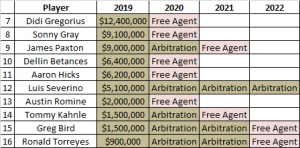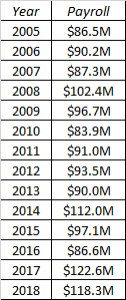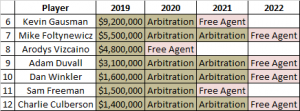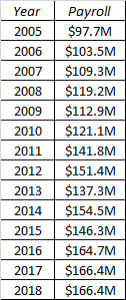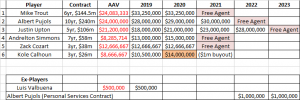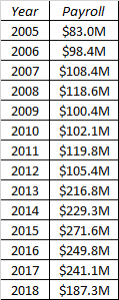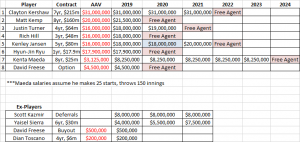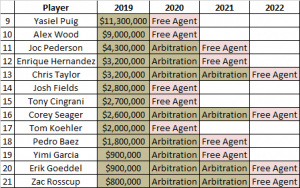MLBTR is publishing Offseason Outlooks for all 30 teams. Click here to read the other entries in this series.
The Braves’ intriguing assemblage of young talent has already proven capable of winning a surprise division title, but there’s still work to be done if GM Alex Anthopoulos is to preside over a perennial contender.
Guaranteed Contracts
- Freddie Freeman, 1B: $65MM through 2021
- Ender Inciarte, OF: $21.025MM through 2021 (includes buyout of 2022 club option)
- Julio Teheran, SP: $12MM through 2019 (includes buyout of 2020 club option)
- Darren O’Day, RP: $9MM through 2019
- Tyler Flowers, C: $6MM through 2019 (includes buyout of 2020 option)
Arbitration-Eligible Players (projections via MLBTR contributor Matt Swartz)
- Kevin Gausman (4.151) – $9.2MM
- Mike Foltynewicz (3.163) – $5.5MM
- Arodys Vizcaino (5.168) – $4.8MM
- Adam Duvall (3.096) – $3.1MM
- Dan Winkler (4.000) – $1.6MM
- Jonny Venters (5.159) – $1.5MM
- Sam Freeman (4.066) – $1.5MM
- Charlie Culberson (3.084) – $1.4MM
- Non-tender candidates: Duvall, Venters, Freeman
Free Agents
- Brad Brach, Lucas Duda, Ryan Flaherty, Nick Markakis, Brandon McCarthy (retired), Peter Moylan, Rene Rivera, Anibal Sanchez, Kurt Suzuki
[Atlanta Braves Depth Chart | Atlanta Braves Payroll Outlook]
Braves fans rightly basked in the success of the club’s fun and youthful 2018 roster, which won the NL East and reached the postseason for the first time since 2013. Of course, as the club’s front office acknowledged, being bumped from the tournament by the Dodgers also served as a reminder of the work left to be done. Overcoming the consecutive National League champs isn’t the only looming hurdle — within the division alone, the Nationals, Phillies, and Mets are all positioned to add additional pieces this winter to their already-talented rosters.
It’s unlikely the Atlanta organization will out-spend those organizations, but that doesn’t mean it won’t have as much or more free cash to work with this winter than almost any (excepting the Phillies) of its chief rivals. The Braves have started each of the past two seasons at around $120MM in payroll. That’s expected to move up, due in no small part to a ballpark-driven profit surge, though the upper boundary isn’t really clear and may also not be reached during the offseason. As things stand, the team is slated to pay something on the order of $75MM to less than half of its roster: Freddie Freeman ($21MM), Darren O’Day ($9MM), Julio Teheran ($11MM), Ender Inciarte ($5MM), and Tyler Flowers ($4MM) have guaranteed contracts. Kevin Gausman, Mike Foltynewicz, and Arodys Vizcaino project to cost about $20MM, while the club will surely spend a few million more to keep some of its other, less-expensive arb-eligible players.
As MLBTR contributor Rob Huff just examined in full detail, it certainly seems as if the Braves will have something in the realm of $50MM to play with in 2019 payroll, if not even more, though that still probably comes with some caveats. For one thing, Anthopoulos has also repeatedly cautioned against expecting a monumental outlay in free agency. (For instance, he has said: “I think the one [signing] where you scratch and really push, and you want to call it overpay in years or dollars, you feel like that’s the one final piece….I don’t think we’re there yet right now.”) For another, the club may be wary of committing too much future money to lure free agents in a bid to improve the current roster. Binding up long-term payroll space, after all, could create downstream problems when it comes time to add new pieces and pay the young players who are currently forming such an intriguing core.
Wild spending won’t happen, but there’s flexibility aplenty. In theory, at least, the Braves can afford to acquire just about any player they want, and they can fit multiple significant salaries if they’re willing to forego the top-tier free agents. With so much near-term availability, one possible strategy would be to front-load any significant free-agent deals, thus increasing the value of their offer while keeping future balance sheets clear, much as the Cubs did when they signed Jon Lester. Meanwhile, the Braves have one of the most compelling treasure chests of trade assets in baseball. In particular, young arms abound, and the Braves will surely explore parting with some to condense a relatively expendable portion of their talent base into MLB assets.
So, where are the needs and how might they be addressed? While the roster holes are mostly on the position-player side, I’d actually argue that the pitching staff warrants just as much attention. That may raise some eyebrows at first glance, as the Braves received strong contributions from a variety of hurlers in both the rotation and bullpen in 2018. As a team, the Braves finished with the seventh-best ERA in baseball, but they were 11th in FIP, 16th in xFIP, and 18th by measure of SIERA. More importantly, virtually all of the team’s key pitchers outperformed their peripherals, some by quite a margin.
To be sure, the Braves do not lack for depth or youthful upside. But the club does not have the established, top-level performers on the mound that it does in its lineup. If Foltynewicz is something of an analog for Ozzie Albies — both have now turned in highly productive, albeit somewhat flawed, seasons — there’s no equivalent for Freddie Freeman (top-end star) or Ronald Acuna (phenom who has shown his ability plays over an extended stretch at the highest level).
That’s not to say that the Atlanta organization simply must have those kinds of players, though that’s arguably what they ought to be seeking. Sean Newcomb and Kevin Gausman both have interesting arsenals, but neither has established himself as anything approaching a rotation anchor. (Gausman did have a nice run upon landing in Atlanta, but his peripherals and broader track record tell a different story.) The Julio Teheran roller-coaster is by now well-documented. Mike Soroka has fascinating near and long-term potential — if healthy — while there’s plenty of talent but still plenty of uncertainty surrounding Touki Toussaint, Luiz Gohara, Kyle Wright, Max Fried, Kolby Allard, and the variety of other promising hurlers who have already debuted, have already made it onto the 40-man roster, or are coming up behind that group. Simply put, the Braves can’t dole out MLB rotation opportunities to all of these arms, particularly given that the team has flipped the switch to contending. And the 40-man pressures will only build, both as near-term improvements are made and as additional talent presses toward the majors.
Adding a veteran piece to replace the outgoing Anibal Sanchez, or simply to re-sign him, feels a bit underwhelming. Rather, there’s a strong case to be made that this organization ought to put on a full-court press to get elite, established talent in the rotation, if not also the bullpen. The Braves could easily afford free agent Patrick Corbin, if they are willing to do a longer deal in order to grab his relative youth. He’s also a target for quite a few other clubs, of course. They might prefer a shorter commitment to Dallas Keuchel, J.A. Happ, or Charlie Morton, though it’s arguable that none of those hurlers has quite the upside the Braves ought to be seeking. That leaves the trade market for a big arm. The Braves should certainly also be heavily involved if the Indians get serious about dealing one of their three excellent starters — Corey Kluber, Carlos Carrasco, and Trevor Bauer — or if the Mets are willing to send Noah Syndergaard to a division rival. Those players will all cost major talent.
My favorite pet theory, though, involves a match with the Diamondbacks on Zack Greinke, who is still owed $95.5MM in salary (plus a $2MM assignment bonus) but will only be on the books for three seasons. Greinke comes with a seemingly appealing blend of veteran gravitas and ongoing excellence; it’d be a splurge, but a measured one. Arizona would surely hang on to some of the obligation or include other talent to help balance things out; regardless, the Braves shouldn’t need to pony up their best young talent unless significant other pieces would come with him. That said, it is notable that the D’Backs have other assets that would make quite a lot of sense on the Braves roster, perhaps including outfielder David Peralta, or relievers Archie Bradley and Brad Boxberger.
Atlanta’s relief core isn’t an altogether different scenario from the rotation. Young southpaw A.J. Minter is a stud and Arodys Vizcaino still misses plenty of bats (at least when he’s healthy enough to pitch). Dan Winkler, Shane Carle, Jonny Venters, and Jesse Biddle were all useful MLB relievers, while Chad Sobotka showed promise. Darren O’Day has always been effective, so he’s a strong bounceback candidate. Several of the leftover rotation pieces could certainly check down into relief work.
Again, there’s no strict need, but there is opportunity. With short-term payroll space available, adding relief pitching is a great potential way to boost the team’s outlook while steering clear of long-term entanglements. Some fans will clamor for the return of Craig Kimbrel, but he figures to take a larger and longer contract than will be comfortable for the Braves. Veteran David Robertson is still performing at a high level and might be a reasonable risk, while Jeurys Familia presents a younger target with plenty of high-leverage experience. Adding a lefty is arguably not a priority, but Zach Britton and Andrew Miller are intriguing players to take a risk on; the latter may be particularly interested in the possibility of playing near his Florida home. The Braves also have just the right kind of assets to entice the Mariners to part with Edwin Diaz, the jewel of the relief market. If his price proves too lofty, Seattle’s Alex Colome might still present a worthwhile target, as might Mychal Givens of the Orioles. There are loads of other possibilities among both righties and lefties.
Even if the Braves don’t make major additions in either area of the pitching staff, they’ll likely find some veteran depth pieces that fit. It’s a much greater necessity, though, to address some of the openings on the position-player side of the roster. A major element of the Braves’ success in 2018 was the fact that both Nick Markakis and Kurt Suzuki exceeded expectations. Those veterans are now gone — Suzuki, at least, has already firmly moved on by signing with the Nats, while Markakis is still a free agent — leaving opening and opportunity in their wake.
Replacing Markakis is perhaps the one true imperative facing Anthopoulos this winter. The outfield has two clear regular assets: Acuna, an incredible talent who just won the NL Rookie of the Year Award, and center fielder Ender Inciarte, who is at most an average hitter but delivers strong value in the field and on the bases. While a return for Markakis perhaps profiles as a backup option, his uninspiring second half and relatively advanced age makes a new addition seem likely.
There has been plenty of debate over Atlanta’s ability and willingness to make a real run at Bryce Harper. Needless to say, he’d come with plenty of risk, but also the potential to be another core asset. It’s frankly difficult to know how plausible that outcome really is, but it seems fair to assume generally that bigger-budget clubs will have a greater tolerance for the long-term risks than will the Braves. Otherwise, the top two corner pieces on the open market are Andrew McCutchen and Michael Brantley, and it’s easy to imagine the Braves coming away with either. A.J. Pollock is a center fielder by trade, but that shouldn’t take him out of consideration entirely. There is a variety of cheaper, likely part-time players also available via free agency.
On the trade market, one-year rental targets include Nicholas Castellanos and Avisail Garcia, though both have their limitations and aren’t particularly cheap. It’s conceivable the club could line up some kind of contract swap arrangement, possibly involving Teheran and/or O’Day, with players such as Kole Calhoun, Wil Myers, and Dexter Fowler representing conceivable fits if the money is sorted in a favorable manner. There aren’t many intriguing, obviously available corner outfielders who come with affordable control rights. David Peralta and Kyle Schwarber could hold appeal, though it’s hardly imperative for their respective teams to move them. The Padres, Phillies, and Brewers all have multiple youthful outfielders who are likely available via trade, though it’s fair to wonder whether any is a sure enough commodity to be installed as a primary corner piece for the Braves.
If there’s a dream player that just might be available, it’s Mitch Haniger of the Mariners. He’ll turn 28 before entering his final pre-arb year, leaving four cheap seasons of prime years still to go. Haniger improved on his impressive first season in Seattle, slashing a robust .285/.366/.493 with 26 home runs in 683 plate appearances last year. The M’s, of course, are launching a roster tweaking offseason in which they won’t prioritize their ability to contend in 2019. With an eye on a quick rebound, the Seattle organization likely does not intend to move Haniger. But it’ll have to consider the possibility and will assuredly have its interest piqued by many of the Braves’ top prospects, many of whom could be ready to contribute by the time the Seattle club hopes to be gearing back up. There are loads of other interesting potential matches between these organizations, each of which are led by GMs with a flair for dramatic swaps. (As noted above, Diaz would look awfully nice anchoring the Braves pen.) And the Atlanta payroll flexibility could leave the club well-situated to absorb some bad contracts to help facilitate a move.
That’s just supposition, of course, but it’s the type of deal that Anthopoulos should and surely will explore in the outfield and other positions. Catcher, clearly, is another need, though it’s one that may well be filled by a less-than-splashy acquisition. With the sturdy Tyler Flowers still on hand, the Braves could seek a Suzuki replacement that will function in a timeshare. Of course, the prospect capital on hand also makes Atlanta a prime possible pursuer of Marlins star J.T. Realmuto, who staked his claim in 2018 as the top catcher in the sport. That’s the kind of major move that could firmly tilt the balance in the Braves’ favor, though indications are that the Marlins’ asking price is exceedingly painful at the moment.
Top free agent Yasmani Grandal could also be a target. Anthopoulos is plenty familiar with him from their mutual time with the Dodgers, and it’s possible there will be a chance to achieve value given Grandal’s notably tough postseason. After all, he has been an exceptional all-around regular season performer for some time now. Wilson Ramos is a possibility, though he’d probably fit better on an American League roster, while valued defender Martin Maldonado and the offensively proficient Robinson Chirinos are perhaps the best of the remaining open-market options.
The remainder of the position-player mix offers several conceivable avenues. One of the most interesting questions is to what extent the organization will at least consider making a move on the left side of the infield. We know, we know, Anthopoulos has repeatedly expressed confidence in Dansby Swanson and Johan Camargo. It seems obvious he’d be comfortable rolling with them again at short and third, respectively, though it remains tantalizing to consider the alternatives. Manny Machado is about as unlikely a target as Harper, but can’t be ruled out entirely. Josh Donaldson would be a great player to take a short-term risk on, bringing quite a lot of upside while keeping the seat warm for rising prospect Austin Riley. Even Mike Moustakas could be a part of an infield rotation. In any event, adding a significant player at the hot corner would likely mean bumping Swanson and Camargo into joint duties at short and as reserves elsewhere. That could make for a strong overall unit. It may be a low-likelihood outcome, but an upgrade on the left side seems at least a possibility, particularly if Swanson or Riley is included in some kind of significant trade.
Finally, position-player depth stands as a general goal — though the route to achieving it will depend upon what other moves are made. Utilityman Charlie Culberson is in line to return after a productive (albeit questionably sustainable) 2018 season. Beyond that, there are two openings for reserve/platoon pieces. There’s probably an argument that the club ought to move on from Rio Ruiz if he can’t hold down a MLB roster spot, given the ever-present demand for more 40-man space, though he remains optionable and could be stashed at Triple-A as a depth piece. At a minimum, though, he’ll end up competing with some non-roster invitees and other existing assets in camp.
At least one bench spot will surely go to a player with significant outfield experience. Even if they add a true regular at one corner outfield spot, the Braves could hunt for a reserve who can spell Inciarte at times against lefties, as that has been a particular area of struggle for him. Adam Duvall has the right profile as a complementary piece, as he’s a good defender with power who could also be a worthwhile late-inning pinch hitter and defensive substitute, but his disappointing 2018 season makes his projected salary seem steep. Acuna’s ability to play center means the Braves have plenty of flexibility in what type of player they end up landing; the skillset of the primary corner piece (as discussed above) will surely be a factor in driving the decision-making on the reserve option.
Clearly, there’s abundant opportunity here for Anthopoulos to sort through. What’s most exciting for the Braves organization is the fact that the possibilities extend both to the near and long-term. The core is not only capable of winning now, but is still fully emerging as talent continues to surge upward. Meanwhile, Atlanta has ample open 2019 payroll as well as long-term contract capacity, since its only lengthy commitments on the books (Freeman, Inciarte) look to be firmly in the black. It’s difficult to imagine a scenario where the organization fails to remain competitive for some time to come, though there’s still plenty of variability remaining in the season to come and beyond. With the Braves looking to move from the realm of overflowing promise to that of perennial achievement, this offseason seems sure to present some highly consequential decisions to Anthopoulos and company.

